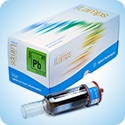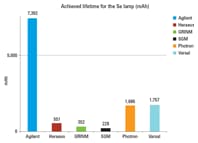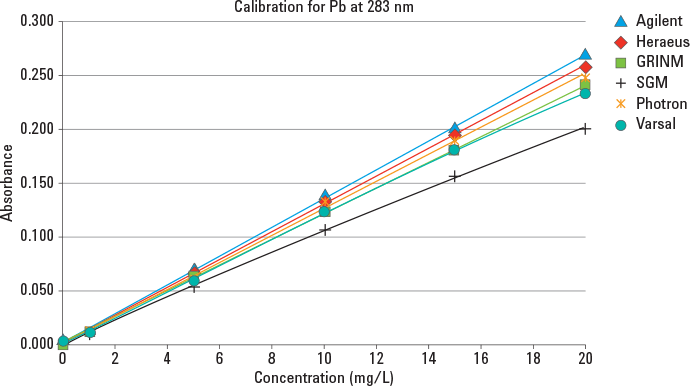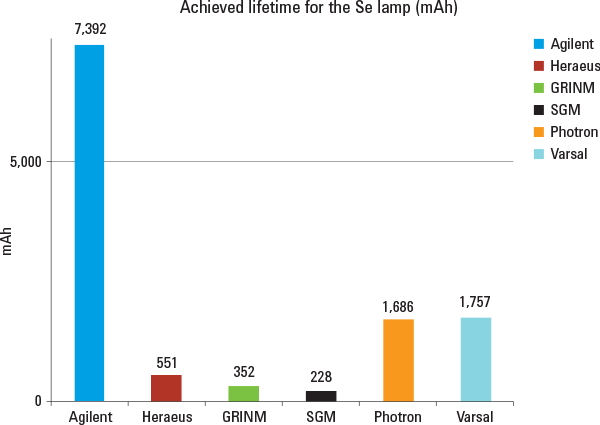Access Agilent eNewsletter February 2015
>> Update My Profile | Subscribe to Access Agilent | Article Directory

Improve your atomic absorption results with high quality HC lamps from Agilent
By Eric Vanclay
Agilent Spectroscopy Consumables Product Manager
and Alejandro Amorin
Agilent Technical Marketing Engineer
Hollow cathode discharge lamps produce a spectral line source for atomic absorption (AA) spectrometers. The key requirement for these lamps is to generate a narrow emission line for the element, with sufficient spectral purity and intensity to achieve good calibration (preferably linear) with low noise.
While many analysts will assume the performance of lamps from different manufacturers is virtually the same, in reality, there are often significant differences that can directly affect the reliability of their AA results. Typical problems can include low sensitivity, high noise, greater calibration curvature, and poor lamp stability.
Recently, we compared the performance of Agilent Hollow Cathode Lamps for selenium and lead with the lamps from other suppliers. Selenium was selected because it has relatively low intensity, and lead because it is one of the more volatile elements. Lead lamps typically have good intensity but poor lifetime.
 Enlarge
Enlarge
Figure 1. Comparison of calibration curves for lead at 283.3 nm. The Agilent lamp provides the best sensitivity and linearity.
Achieve better sensitivity and calibration linearity with Agilent lamps
Calibration linearity relies on the absence of neighboring interfering emission lines (dependent on the cathode composition) and the recommended operating current. Where these interfering lines occur, the use of a higher operating current can increase the prominence of the main resonance line, reducing the interference. Alternatively, a narrow slit can be used to improve resolution and isolate the resonance line from the interfering line. However, this reduces light reaching the detector, increasing noise. Use of a higher operating current can also distort the emission peak, reduce sensitivity, and introduce pronounced curvature in the calibration.
Most lamps use optimized operating parameters, which balance the key influences required to obtain good sensitivity, high signal-to-noise (S/N) and adequate lamp life. We assessed calibration linearity for several lamps operated at the manufacturer’s recommended operating conditions by overlaying the calibration curves generated using the same set of standards.
Analytical sensitivity was determined by comparing the absorbance values. The Agilent lamp delivered the best sensitivity and linearity for lead (Figure 1) and the second best sensitivity for selenium.
 Enlarge
Enlarge
Figure 2. Long-term stability for selenium (Se) lamps based on measured absorbance for a 120 mg/L calibration standard. The solid red lines show control limits of ± 5%. The Agilent lamp shows the best long-term stability with minimal variation over the duration of this test.
Achieve better long-term stability with Agilent lamps
For best performance and stability, hollow cathode lamps should be switched on and warmed up before commencing analysis. Lamps that require excessive stabilization times or never reach equilibrium create problems. Once analysis begins, drift in lamp intensity changes the analytical signal, introducing significant errors. This is especially critical at trace levels where the drift can exceed sample absorbance.
In this example, we assessed long-term stability by reading the absorbance of a standard that gave good S/N performance, every two minutes for an hour (after a 10 minute warm-up time). The Agilent selenium lamp provided good long-term stability with an average precision of < 1% RSD, compared to > 3% RSD for the worst performing lamp (Figure 2). The Agilent lead lamp also provided good long-term stability with an average precision of < 1.6% RSD, compared to > 2% RSD for the worst performing lamp.
We also tested the short-term stability by monitoring the emission signal from the lamp continuously over 20 minutes, after a 10-minute warm-up. While the Agilent lamp and some others were stable, the signals for some lamps showed large spikes and never appeared to stabilize. Variations of this magnitude can cause serious analytical errors.
 Enlarge
Enlarge
Figure 3. The Agilent selenium hollow cathode lamp delivers the longest lifetime.
Achieve longer lifetime and reduced operating costs with Agilent lamps
Useful lamp life depends on the gas fill inside the lamp. However, a compromise in the gas fill can be required to ensure an adequate lamp life – while still achieving good emission intensity and high S/N performance. For this test, lamp lifetime was measured by operating the lamp continuously (at the manufacturer’s recommended operating current) until failure occurred i.e. when the lamp produced no detectable emission or an excessively unstable signal. The Agilent selenium lamp gave the longest life, well over four times longer than the nearest competitor (Figure 3), and the second longest life among the lead lamps (5,594 mAh compared to 6,321 mAh).
Wide range of Agilent AA lamps for all applications
Agilent offers an extensive range of conventional single element and multi-element lamps. Our uncoded hollow multi-element and uncoded single element lamps work well with most major brands of AA instruments (except PerkinElmer and Shimadzu instruments that have self-reversal correction).
Agilent coded multi-element and coded single element lamps use automatic lamp recognition to reduce operator error with multiple lamps in Agilent AA instruments. We make it easy for both experienced or novice AA users to achieve the best analytical performance, by providing clear guidelines on lamp operating conditions.
Our comprehensive range of UltrAA high-intensity boosted-discharge hollow cathode multi-element and single-element lamps can replace conventional lamps – and deliver lower detection limits for the most demanding AA applications.
For more information, please request a complimentary Agilent Periodic Table/AA Lamp Selection Poster. Then explore Agilent Application Note Features and Operation of Hollow Cathode Lamps, Agilent UltrAA lamp technical overview, and Agilent lamp FAQs (including typical gain settings).
>> Update My Profile | Subscribe to Access Agilent | Article Directory
Figure 1.

Comparison of calibration curves for lead at 283.3 nm. The Agilent lamp provides the best sensitivity and linearity.

